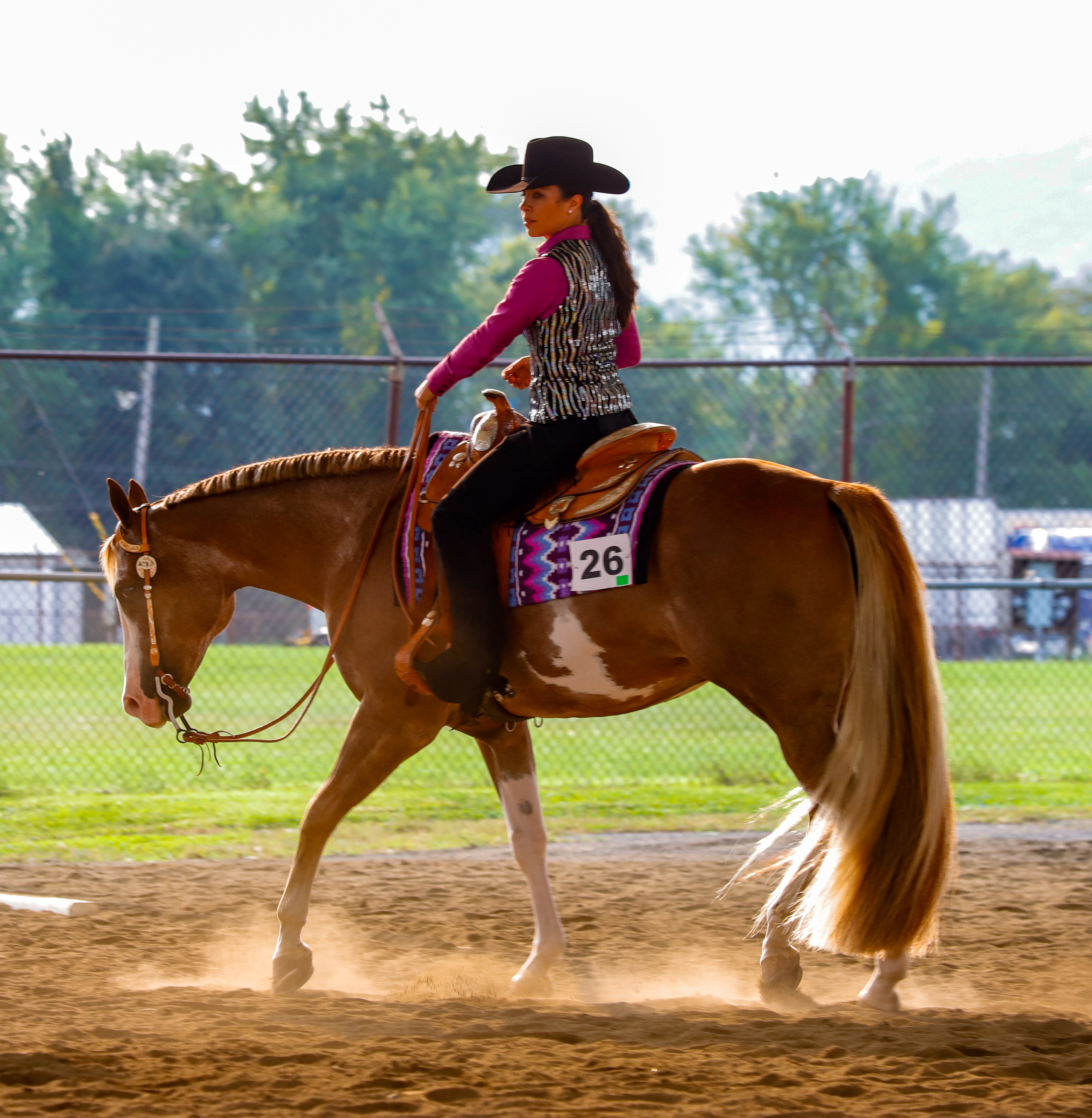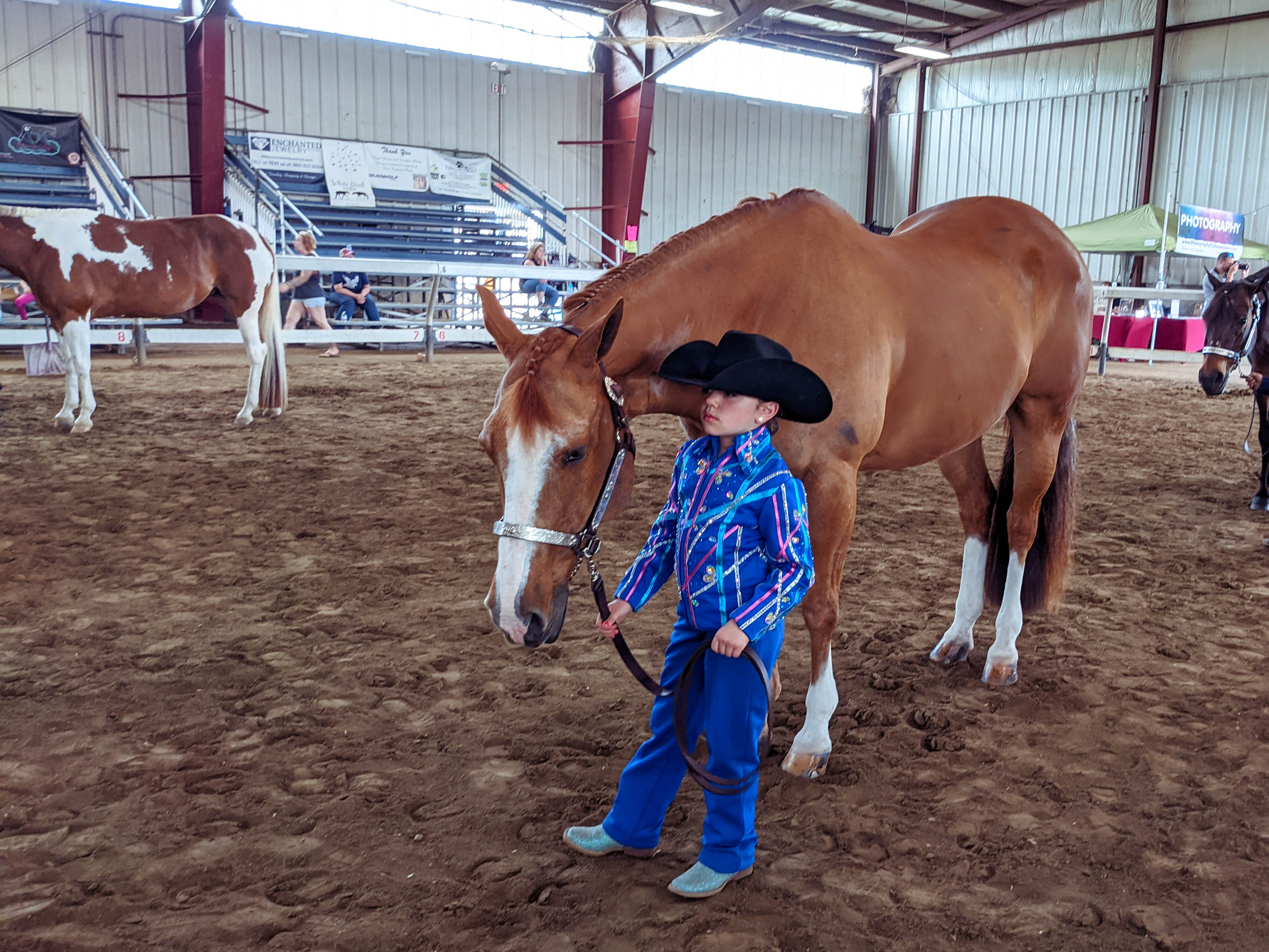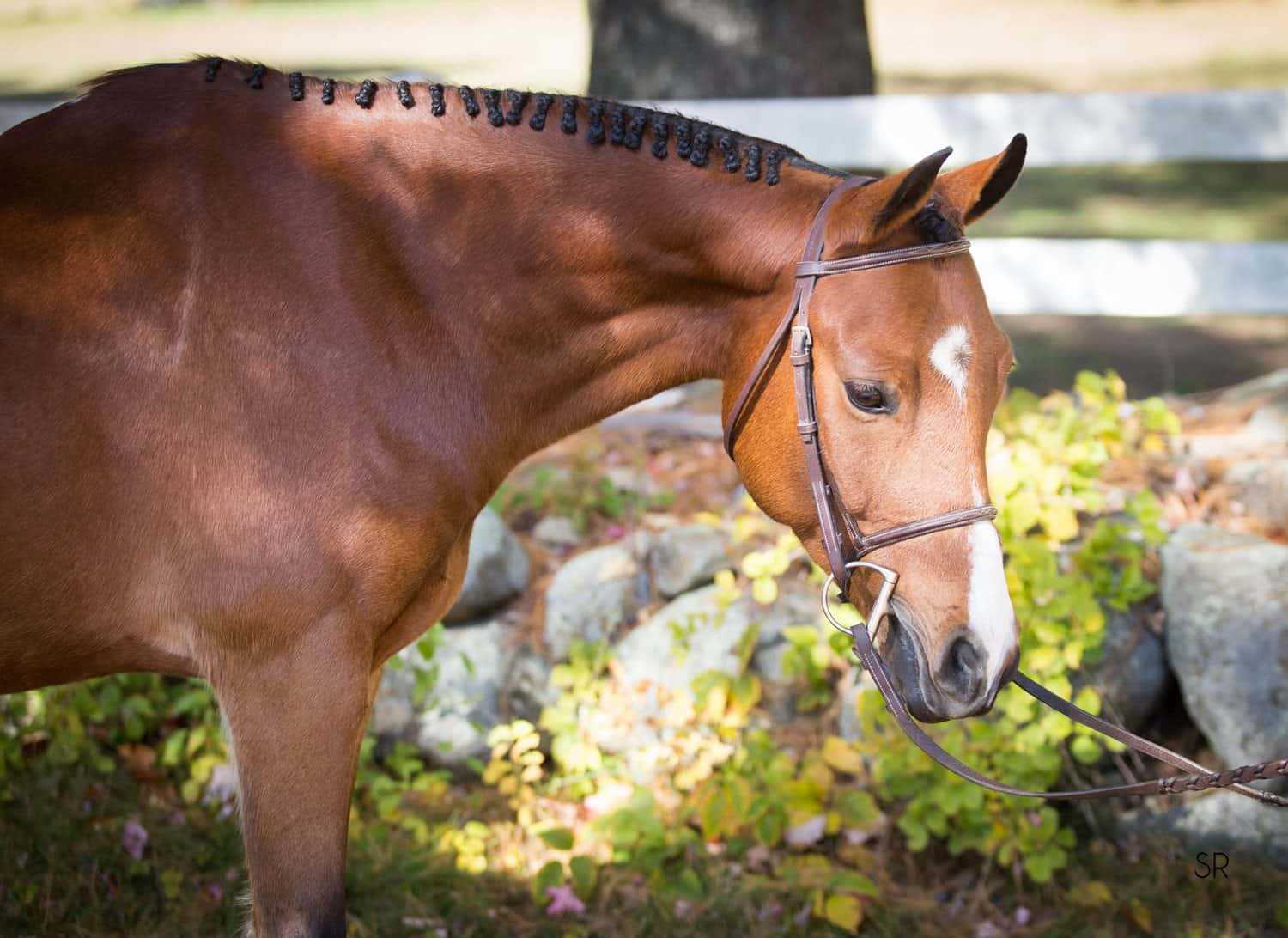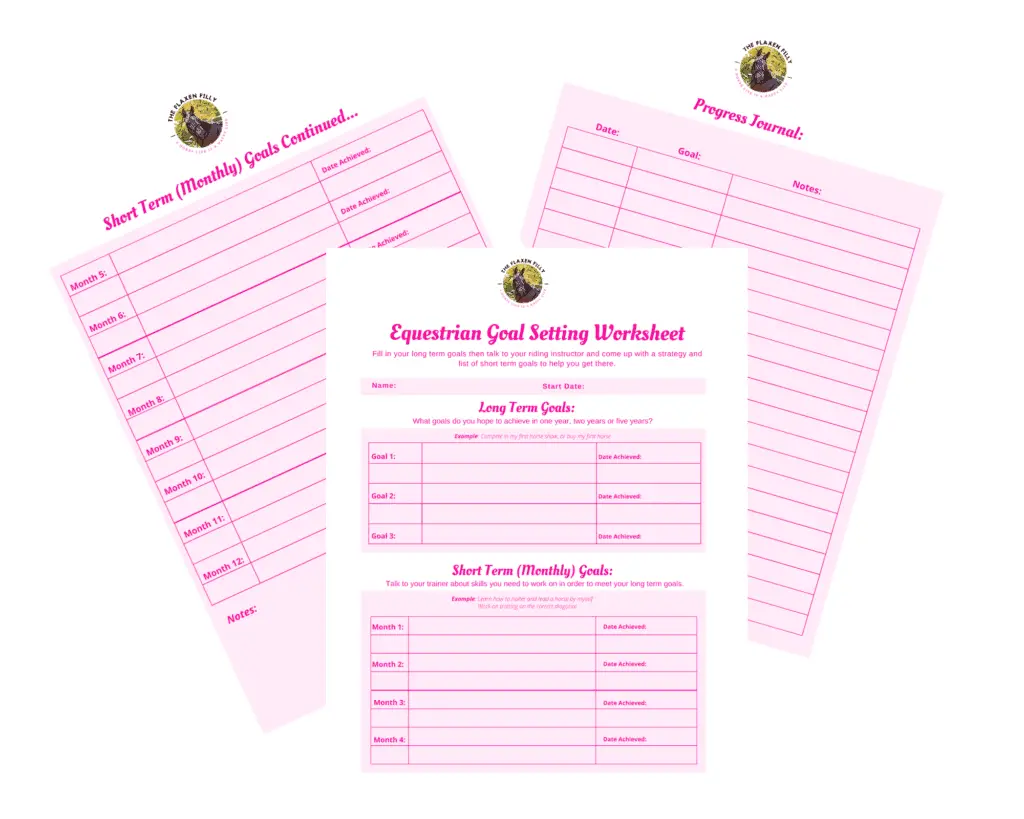If you’ve ever been to a horse show you know the amount of work that goes into preparing is enormous. Between packing, washing, tack cleaning, riding, practice, learning courses and patterns and paperwork it can be stressful.
That’s why you need a good system in place. After showing on different circuits and at a variety of types of shows for many years, I’ve figured out what works well for my horses and family. The key is to adapt the system to your own personal horse, horse trailer storage and type of show you attend. In this article, I’ll share with you every step we take to prepare for a horse show at home and at the show.
This post may contain affiliate links which means that I may earn a small commission at no extra cost to you. As an Amazon Associate I earn from qualifying purchases.
Bathing Your Horse
I like to wash my horses the week before the show to get them clean and shiny before the show. I do this for two reasons. 1) The horses’ hair will be clean for clipping, mane pulling and other pre-show tasks 2) I’ve found my horses stay shinier if I bathe them 2 to 3 days ahead of time instead of right before the show. Also, any additional washing, touching up or last minute spot removal is easier if the horses are already clean.
If you want to know more about how I bathe my horses to get them super clean, you can read more about it here: How To Bathe Your Horse For Beginners
I still spot clean at the show to remove stains from white spots and to clean sweat. At a one day show this might mean using a cloth or sponge and a bucket and some green spot remover. However, at weekend shows the horses sometimes sweat during practice rides. So, we end up rinsing them off to remove sweat and then washing dirt of their legs with shampoo. Sometimes I will wet and condition their tails depending on how much dirt gets in the ends from our practice sessions.
Depending on the duration of the show, the horses might need to get bathed more than once. For example, when I attended the Pinto World Show we were at the show for over two weeks. And, the weather was very hot, so I washed my horse several times during the show.
These are my favorite bathing products that I use on my horses.
Clipping Your Horse
If you plan to clip your horse for the show, I suggest doing it at home in advance of the show even if you are attending an overnight show where you plan to arrive a day or two early. Clipping can be stressful for some riders and horses so it’s best not to leave it until the last minute. I like to clip my horses a few days before the show and then if a touch up is needed at the show it is quick and easy.
If you or your horse are new to clipping, practice clipping way in advance of the show. And, get some help from your trainer or an experienced friend. It’s important to make clipping a positive experience for your horse if you plan to show regularly. Dreading the task of clipping will only add more stress for both you and your horse.
And, as I mentioned above, make sure you are clipping clean hair. Always wash your horse before clipping and allow the hair to dry completely to minimize the risk of lines.
Mane Pulling & Banding Or Braiding
If you plan to attend a one day show, you’ll need to band or braid your horse’s mane the day before the show. You likely will not have enough time to band or braid the same day you are showing. If you are new to horse showing, overloading your plate and rushing to complete tasks will make the show extremely stressful. After your horse is banded or braided you’ll need to protect his mane until it’s time to show. I recommend using a hood to keep his mane in place.
Alternately, if you will be attending an overnight show you will most likely arrive before the horse show starts. In this case, I still recommend pulling your horse’s mane at home before you depart for the show, if it needs it. Then you can easily band or braid your horse’s mane once you arrive at the show. I don’t band my horse at home before the show when we are going for the whole weekend because when the weather is hot, I don’t want to put a hood on my horse in the trailer to keep it clean and flat. And, if my horse gets sweaty during practice, requiring rinsing or washing, then I risk his mane become frizzy and fluffy if it gets wet.
I don’t pull my horses’ manes for every show and I try to keep mane pulling to a minimum since most horses don’t like it. In the spring when I clean up my horses from winter I pull their manes over the course of a couple of days instead of removing a lot of hair at once. Then a few days before each show I simply touch up the thickest part of the mane just to make sure it’s even. I’ve found my horses are happier when I maintain their manes a little at a time all season long. Luckily, we have a couple of horses with thinner manes that never require pulling, so they just get a trim instead.
Preparing your horse’s mane correctly is an important step if he is going to have his mane banded or braided for the show. This will keep the bands and braids even and help the mane lay correctly on the horse making him look more polished and presentable.
In either case, once your horse has been braided or banded, I recommend using a hood to protect it from getting dirty or coming undone. These Sleazy Sleepwear hoods are my favorite, and they are made in the USA.
Packing The Horse Trailer
Whether it’s packing for a horse show, moving, de-cluttering or vacation, my least favorite task for any reason is packing. It’s a pain! Why? Because you have to do it right. Packing correctly takes planning, having the right storage equipment and using the space you have available efficiently.
By the way, check out my complete horse show packing list so you don’t forget anything!
Think about which equipment you’ll need first when you arrive at the show. For me, the most crucial aspect of packing and planning for the show is making sure that certain equipment is easy to retrieve from our trailer tack room.
When we arrive at a show there are supplies we need right away which include, a wheelbarrow to transport items from the trailer to the stalls, water buckets, water bucket hangers, and tack stall equipment like saddle racks. This means that when we pack the trailer, these items are packed last and near the tack room door.
Also, in the case of a problem during traveling like a flat tire, you need to be able to access your water and water buckets for the horses. If the weather is hot and you are stuck on the side of the road for a while, you will need to be able to keep the horses comfortable and the trailer tends to get hot. We always travel with some water from home, a hose and water buckets. Most gas stations have a water spigot so bring a hose and leave it where you can access it during the drive.
Setting Up At The Horse Show
We like to spread bedding in the stalls and setup a water bucket for each horse. Then we unload the horses, and put them in their stalls with hay. Once the horses have hay and water, we start to set up everything else.
So, things like saddle racks, bridle racks, and other organizational items get set up. If we unload all the tack and equipment with no racks etc. already in place, then we have a huge pile of stuff and no where to put it.
Schneider’s Saddlery has a variety of tack stall organization tools and racks that we really couldn’t live without.
When we set up at a one day shows we like to bring pop-up tents so riders can get some shade, along with chairs and folding tables. Snacks and water to keep everyone fed and hydrated. It’s easy to forget to eat and drink when you’re busy at a show. We also set up a grooming station with everything we need for polishing coats, hanging tails, repairing damage to manes, safety pins, brushes, hoof polish etc. That way everyone showing knows where to find the supplies they need. Tack gets set up in a separate area near the truck and is organized by horse.
For overnight shows we like to use two tack stalls, one for tack and horse supplies and the other for show clothing, snacks and supplies for humans. This helps to keep hay and dirt off of clothes and out of makeup and food.

Check In At The Office
Once the horses are settled and the equipment is unloaded and set up, the next task is to take your paperwork to the office. Most horse shows allow you to pre-enter online these days but you still have to bring veterinary paperwork like rabies certificate and proof of negative Coggins, breed association papers and proof of membership to the office when you arrive.
At this time you’ll also review your entries to confirm they are correct and retrieve your horse show number. Some shows allow you to keep the same number all season so you may not need a new one at each show. Secondly, some horse shows require you to leave an open check at the office at the start of the show and then reconcile your bill before you leave. Check the rules for the horse show you are attending and make sure you have all of the proper paperwork and payment ahead of time.
Lunging Your Horse
Depending on your horse’s personality, energy level and how often they travel, you may need to lunge your horse after you arrive at the show.
I like to lunge my horses no matter how seasoned they are for multiple reasons. First, it gives them a chance to look around and take in their new surroundings. Secondly, after a ride on the horse trailer and then sitting in a stall its nice to give them a chance to stretch.
If your horse doesn’t need to lunge it’s still a good idea to hand walk a lap around the show grounds before getting on. This way you can asses if there are any areas he is afraid of without risking a spook and falling off.
Warm-Up Ride
Once you’ve unpacked and your horse has had a chance to look around and settle in, it’s time to ride. If you are new to showing you most likely have your trainer at the horse show with you. Even if you’re not new to showing, I highly recommend attending shows with your trainer and following their advice. Under the pressure of competition emotions tend to run high, having a calm, objective coach will help you work through frustrations. Everyone needs eyes on the ground, in fact I even wrote an entire article on this topic, check it out here:
Warming up may have many different interpretations. Every horse is different. When I’m showing, the two horses I ride require very different warm-up routines to get ready to show. You need to evaluate your horse and your experience and have a plan ahead of time. However, plans don’t always work out so you should be adaptable or have a back up plan. Your horse may be wound up and require much longer to focus that you anticipated. Or, you might anticipate a long warm-up for a green horse only to find that they fizzled out quickly and you need to cut it short and let them rest.
Don’t copy what other riders are doing, do what is best for your horse and listen to your trainer. No matter what.
It’s easy to get sucked into thinking you’re doing something wrong because other people are taking a different approach. And the warm-up pen is your first chance to compare yourself to others which only leads to disaster. Don’t do it, just focus.
Remember, their horse is different, their coach is different, their riding style is different and their experience level is different. Which means their needs are different than yours.
Download your FREE Equestrian Goals Worksheet and start achieving your goals today!
Grooming Before Your Class
Now that your horse is warmed-up it’s time to get ready to show. These are the areas I focus on when I tack up my horse to enter the show arena:
- Coat Polish
- Clean Face
- Forelock – if not done at the same time as the mane
- Clean Legs & White Spots
- Hoof Polish
- Tail
- Face Grease – depending on the class
First and foremost, your horse needs to be clean. If you horse gets dirty or sweaty during the warm-up, remove as much sweat and grime as possible. Once you get your horse dry and clean, next it’s time for coat polish. I tend to go a little overboard here, but just be careful NOT to spray coat polish where the saddle sits. If you buy good quality coat polish the coat will be very slick and shiny and could cause your saddle to slip. I like to use a cloth on my horse after spraying coat polish instead of a brush as I find it makes my horse gleam.
Next, make sure your horse’s face is clean. There’s a good chance your horse has some eye boogers, slobber or dirt on his face. So brush or wipe your horse’s face and get it nice and clean. You can also band or braid your horse’s forelock. Most people braid their horse’s forelock when they do the mane, but when it comes to banding, forelocks don’t always sit right under the hood. I tend to hold off on banding my horse’s forelock until the day I’m showing.
Next I like to use green spot remover to clean any white spots my horse has and clean their legs while I’m at it. If your horse had clean white legs but now they look dusty, you can thoroughly brush them and then use baby powder or touch up spray to make them look clean again.
Once my horse’s legs are clean I apply hoof polish. You can use clear or black depending on your horse’s coloring and what is acceptable at the shows you attend. I also keep a can of hoof polish enhancer in my ring bag so that when my horse’s feet get dusty, I can spray them and make them shiny again. I don’t touch them up all day long but I do like to touch them up before any in-hand classes or if we’re showing multiple days in the morning of each show day.
After my horse’s leg’s and feet are clean and polished, hang my horse’s fake tail. I’m not going to go into detail about hanging a tail as that is a whole article in itself. However, it’s crucial to hang your tail at the correct height for your discipline. You don’t want your horse to step on the tail if it’s too low or look awkward if it’s too high. Also, you should wash and detangle your fake tail just as you would your horse’s real tail, and be gentle.
If you are not using a fake tail then this is a good time to spray detangler or coat polish in your horse’s tail and brush it gently. On a side note, I never brush my horse’s tail unless it has just been washed and conditioned and at horse shows when I know it’s clean and slick. And, I always spray detangler before brushing.
Lastly, depending on the show we are attending and the classes we are entering I put face grease on my horse. I do this step last in an effort to avoid getting grease on anything or anyone. If I’m showing in halter, I will completely prepare my horse, then put his silver show halter on and then put the grease on. Keep the bottle of grease and a damp towel in your ring bag for touch ups.
Here are my favorite horse show grooming products:
Fly Spray
If you’re at a horse show in the heat of summer, chances are you’ve already fly sprayed your horse numerous times. However, once my horse is completely ready to go I like to give them one last thorough coat of fly spray before entering the show ring. Fending off flies is just one more way to set my horse up for success and reduce the chance of an annoyance impacting my ride.
If the class doesn’t go well because I didn’t pilot well or my horse didn’t cooperate, that’s one thing. If a class goes poorly because my horse is getting attacked by flies, that’s different and avoidable. Especially if I’m showing in Halter or Showmanship when my horse needs to stand still for a period of time. Fly spray is absolutely key.
I recommend this fly spray all the time, if you need something strong and reliable to get you through the full show day, you need Pyrannha. It actually works.
Numbers
Some disciplines require the rider to wear the number at horse shows and others require horses to wear the numbers on their saddle pad. If your horse will wear the numbers on the saddle pad you’ll want to make sure they are pinned on straight and that you have two numbers. You should have one number on each side of the horse. Also, be sure to check that your horse is wearing the correct number so you do not get disqualified.
If the rider is wearing the number, make sure it is visible and not being blocked by your hair or clothing. And, again, make sure it is the correct number and sitting straight.
Rider Attire and Presentation
No matter what discipline you ride you’ll need to have attire that meets the requirements of the class(es) you plan to enter. And, the attire should fit correctly and be neat. Your budget for show clothes is not important, what matters is that you are clean, tidy and wearing the appropriate type of attire.
For example, breeches and a helmet are required in a hunt seat class, chaps are appropriate for western classes and some classes require gloves. Different disciplines have different trends they follow for hair styles but regardless of the appropriate style for your class, your hair should be neat. Use lots of hair spray to tame fly aways!
Your clothing, hair, make-up, boots and tack should be as clean and tidy as possible.

Dealing With Competition Nerves
Once you’ve fully groomed and tacked up your horse and gotten dressed you’re likely ready to ride. This is when the nerves might start to creep in.
First, let me start by saying, there is nothing wrong with getting butterflies or nerves or a stomach ache at a horse show. It happens to everyone, and it means you care. Having a little bit of nerves, excitement and anticipation is ok as long as it does not affect your ride.
Handling nerves appropriately can be difficult and it’s a skill that improves over time.
Remember to breath, talk to your coach, remember your strategy for the class and that you have spent a lot of time preparing. The best way to beat horse show anxiety is to be prepared. Remind yourself that you are ready, and keep breathing. Usually once you get going, the nerves fade. Try your best to leave your emotions at the gate and not take them into the class with you.
I always say, it’s ok to feel something but you have to keep it to yourself and not let on to your horse that you’re feeling worried. You can express your feelings to your parent, friend and coach. Not your horse. Don’t transmit that energy to your horse and then expect him to remain calm and focused. Sometimes you have to push your nerves aside, complete your ride and re-visit your feelings later. It’s hard, but you can do it!
I wish you the best, and I hope you found this article helpful! If you did, please share it!



